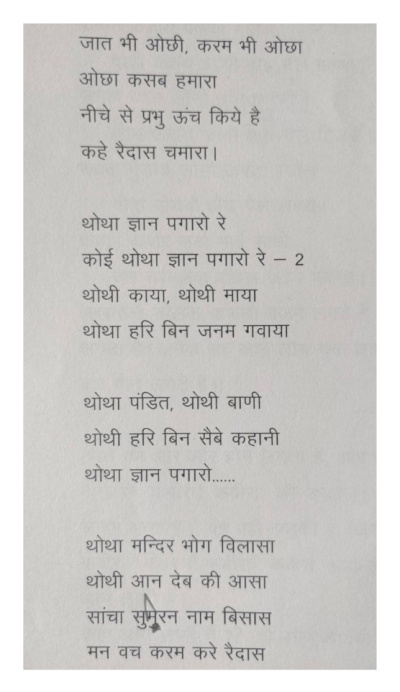Thotha Gyaan Pagharo
The journey of the play «Kabir Khada Bazaar Mein», written by Bhisham Sahni and directed by MK Raina in 1982 in Delhi, has been adapted to the genre of rock opera by the Delhi-based art rock band Dastaan Live. Baan and Anant, members of the band, share an experimental track that juxtaposes two versions of «Thotha Gyaan Pagharo», the version that was a part of the original play and the one that has been reinterpreted in another musical idiom by the band in more recent times. The piece evokes a reflection on the relationship of the iconic play with contemporary times. The composition owes its periodic resurgence in its various forms to artists in the city who have kept engaging with it and shaping it as per the time.

Translated by Dr. Anjali Raina
Somebody learn to reject hollow knowledge,
Discard the concerns of the temporal body,
Of worldly illusions
Do not fritter away your life
Without realizing the almighty
Hollow are the priests, hollow their sayings
Without «Hari» (the Almighty), the entire story is meaningless
The temples are hollow, all worldly pleasures are hollow
Do not waste your life waiting for the savior to appear
The truth is only in the Name
In meditation, in faith
In complete dedication
through the heart, words, and deeds
So says Raidasa
This track owes its origins to an iconic play «Kabir Khada Bazaar Mein» (Kabir is standing in the market) that has been adapted to the genre of rock opera by the Delhi-based band Dastaan Live. Dastaan Live is a collective comprising musicians Anirban Ghosh (bass guitar, spoken word), Nikhil Vasudevan (drums, backing vocals), Fidel (drums, percussions), Anant Raina (percussions), Sudheer Rikhari (vocals), Mohammed Faheem (spoken word, vocals), Jagtinder Singh Sidhu (vocals), Anjali Raina (spoken word, vocals), Amar Sukesh (guitars), Pranay Verma (guitars), and a growing set of visual artists, designers, and sound artists.
This opus stands as homage to the timeless wisdom of Kabir, whose words echo across epochs. The poem by Kabir, the 15th-century poet and philosopher, became part of a play written by the legendary writer Bhisham Sahni, and conceived as a fictionalized account of the life of Kabir. Staged as a theatrical production of the same name by renowned theater and cultural activist M.K. Raina in 1982, and now reinterpreted into an a capella rock opera by Anirban Ghosh with the political art rock collective, Dastaan Live, in 2023, this composition traverses centuries. Etching its significance upon the tapestry of socio-political currents, it is a testament to the mutable meanings it accrues.
The original music for «Thotha Gyaan Pagharo» was composed by the late Panchanan Pathak, a noted theater musician and active member of the Indian Peoples Theatre Association.
«Thotha Gyaan Pagharo», the rendition by Dastaan Live, embarks on a sonic journey, revealing a rich canvas of sound with a maelstrom of voices. Initially appearing as a cacophony, it embodies the tumultuous spirit of the zeitgeist. Interwoven within this vocal chaos are dissonant soundscapes, capturing the unrest of current times. Amidst the pandemonium, a solitary voice – the bastion of reason – remains, struggling to be heard above the disharmony.
The composition evolves from a simple recitation, diverging into paths of differing time signatures, converging on resolute chants as tonal centers shift. This deliberate tonal interplay is accompanied by temporal and atmospheric shifts. Transitioning from pandemonium to tranquility, the audience explores embedded consonance and dissonance. Beyond music, it pays homage to Kabir’s wisdom across epochs.
The musicians, in their intricate orchestration, dabble with creating textures and exploring soundscapes with a range of moods. This delicate balance of textures and harmony adds layers and subtexts to the composition. The percussionists infuse different rhythmic and textural interpretations into the vocal cacophony, creating an ever-evolving auditory landscape.
This piece packs in the chaos inherent in the current times, providing a musical reflection of the complexities and challenges that shape our world today. When juxtaposed with the original rendition, which was characterized by mellow vocal lines and harmonious rhythmic construction, we are granted a poignant glimpse into the transformation that this corner of the world has undergone in the past 20 to 30 years. The evolution from tranquility to dissonance reveals the shifting tides and metamorphosis of artistic expression, echoing the broader societal and political changes and upheavals that have marked our collective journey. As the pandemonium recedes, a serene tranquility envelops the final lines, mirroring the calm that ensues after the tempest’s wrath. The opus toys with consonance and dissonance, embedding discomfiture within the composition, and inviting the audience to explore its depths alongside their own.
This composition is part of the virtual exhibition «Norient City Sounds: Delhi», curated and edited by Suvani Suri.
Project Assistance: Geetanjali Kalta
Graphics/Visual Design: Upendra Vaddadi, Neelansh Mittra
Audio Production: Abhishek Mathur
Video Production: Ammar
Biography
Biography
Shop

Published on September 29, 2023
Last updated on February 21, 2024
Topic
What’s the idea behind a traditional brass band from Vienna playing at 5 am in the morning? How does physical presence of artists affect the music they play?
Special
Snap
